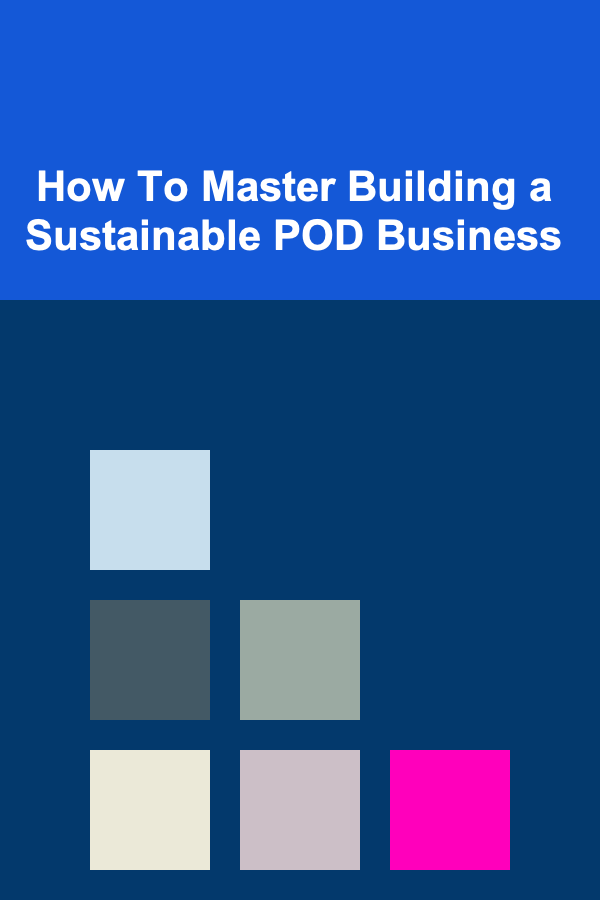
How To Master Building a Sustainable POD Business
ebook include PDF & Audio bundle (Micro Guide)
$12.99$7.99
Limited Time Offer! Order within the next:

The Print-on-Demand (POD) industry has become one of the most accessible and profitable sectors for entrepreneurs in recent years. By leveraging online platforms, sellers can create and sell custom products like t-shirts, mugs, phone cases, and more, without the upfront costs or risks associated with traditional retail. However, while setting up a POD business is relatively easy, building a sustainable and profitable one requires careful planning, strategy, and ongoing effort.
In this guide, we will delve into the steps and strategies necessary for mastering the creation of a sustainable POD business. From understanding the fundamentals to crafting a long-term vision, this article will provide actionable insights into every aspect of the POD journey.
Understanding Print-on-Demand (POD)
Before diving into the steps to building a successful POD business, it's essential to grasp what Print-on-Demand actually entails. In a POD model, the business owner partners with a supplier to create custom products that are only printed and shipped when a customer places an order. The business owner doesn't have to worry about inventory, bulk production, or shipping. Instead, they focus on designing products, marketing, and managing customer relationships.
Key Benefits of POD:
- Low Startup Costs: Since there's no need to purchase inventory upfront, the financial barrier to entry is minimal.
- Low Risk: Because products are made to order, there is little to no risk of unsold inventory.
- Scalability: As orders increase, you can scale your business with minimal additional effort since your POD provider handles production and fulfillment.
- Flexibility: You can easily test new designs or product types without significant investment.
However, while these advantages make POD appealing, the real challenge lies in standing out in an increasingly crowded market. The key to sustainability lies in building a strong brand, offering unique designs, and maintaining excellent customer service.
Step 1: Choose a Profitable Niche
The foundation of a sustainable POD business starts with finding the right niche. A niche is a specific target audience or market segment that has distinct needs, preferences, or interests. It's crucial to select a niche that has both demand and potential for differentiation. A common mistake is trying to appeal to everyone with generic designs, which can quickly get lost among the competition.
How to Choose a Profitable Niche:
- Identify Your Passion: Starting with a niche that aligns with your personal interests and passions can help you stay motivated and engaged in the long run.
- Research Market Demand: Use tools like Google Trends, keyword research tools, and social media to gauge demand for potential niches. Look for topics with a growing community of engaged consumers.
- Analyze Competitors: Research other POD businesses within the niche. Assess what they are doing well, and identify gaps that you can exploit with unique designs or better customer service.
- Assess Profitability: Ensure the niche has room for profitability. You need to be able to offer unique designs that justify a price premium while still ensuring competitive pricing.
Example Niches:
- Pet Lovers: Products with custom pet designs for dog and cat owners.
- Fitness Enthusiasts: Apparel, gym accessories, and motivational quotes for fitness lovers.
- Minimalist Aesthetic: Simple, clean designs appealing to minimalist lifestyle enthusiasts.
- Pop Culture: Merchandise related to popular movies, series, or music.
Once you have identified a niche, narrow it down even further to a sub-niche if possible. The more specific you can be, the better you can target a passionate audience.
Step 2: Design Unique and High-Quality Products
The next step in building a successful POD business is creating products that stand out from the competition. Since you won't be producing physical inventory, your designs will be the cornerstone of your business. It's essential to create eye-catching, high-quality designs that resonate with your target audience.
How to Design High-Quality Products:
- Use Professional Design Tools: Whether you are a skilled designer or not, tools like Adobe Illustrator, Photoshop, or free alternatives like Canva can help you create professional-grade designs. These tools allow you to design with precision and clarity.
- Outsource Design: If you're not a designer, consider hiring a freelance designer from platforms like Fiverr or Upwork. Professional designers can help turn your ideas into visually appealing products.
- Understand Product Quality: Ensure that the products you're designing for are of high quality. Research the materials, fabric types, and printing techniques of your POD provider to ensure the end product meets your quality standards.
- Create Differentiated Designs: Instead of copying popular designs, focus on creating unique and fresh concepts. This will set your brand apart and build a loyal customer base.
Best Practices for Creating Designs:
- Consistency in Branding: Your designs should reflect the identity of your brand. Consistent use of colors, fonts, and styles across all your products helps build brand recognition.
- Appeal to Emotions: Customers often purchase POD items for emotional reasons. Whether it's a funny quote, an inspiring message, or a product that represents their passion, your designs should evoke an emotional response.
- Optimize for Print: Make sure your designs are created with the correct dimensions and resolutions required for printing. Poor-quality designs can result in low-quality printed products, damaging your brand's reputation.
Step 3: Select the Right POD Provider
The POD provider you choose plays a pivotal role in the success of your business. Your provider will handle production, fulfillment, and shipping, so it's crucial to partner with one that aligns with your goals for quality, speed, and customer service.
Criteria for Choosing a POD Provider:
- Product Variety: Choose a provider that offers a wide range of products you can customize. This way, you can experiment with different product types as your business grows.
- Quality Control: Ensure that the provider offers high-quality printing techniques and product materials. Request samples before committing to ensure the end result meets your standards.
- Shipping Speed and Reliability: Look for providers with reliable and quick shipping times. Long delivery times can lead to frustrated customers and lost sales.
- Customer Support: Good customer support is essential when handling returns, exchanges, and other issues. Choose a provider with responsive customer service.
- Integration with E-Commerce Platforms: The provider should seamlessly integrate with the e-commerce platforms you plan to use, like Shopify, Etsy, or WooCommerce.
Popular POD Providers:
- Printful: Offers a broad range of products, including clothing, accessories, and home decor, and integrates with popular e-commerce platforms.
- Printify: Known for its extensive catalog of products and partnerships with a variety of print providers, offering flexibility in product selection and pricing.
- TeeSpring: Ideal for creators looking to monetize their designs on social media platforms like Instagram, offering a wide variety of apparel and accessories.
- Gooten: Provides a diverse product range and focuses on a global fulfillment network for faster shipping.
Step 4: Build Your Brand
Building a strong brand is essential for creating a sustainable POD business. Branding goes beyond just your logo and colors; it encompasses your story, values, and how you communicate with your customers. A well-established brand can help you stand out, command higher prices, and develop long-term relationships with customers.
Elements of Effective Branding:
- Create a Memorable Name: Your business name should be easy to remember and reflect the essence of your brand.
- Design a Professional Logo: Your logo is a key visual representation of your brand. Invest in a professional design that encapsulates your brand's identity.
- Develop a Strong Online Presence: Build a website or e-commerce store that reflects your brand's values. Ensure it's easy to navigate and mobile-friendly.
- Consistency Across Channels: Ensure that your brand's tone, messaging, and visuals are consistent across your website, social media, and marketing materials.
- Connect with Your Audience: Share your brand's story, values, and mission to connect with your customers on an emotional level. Authenticity can foster brand loyalty and encourage word-of-mouth marketing.
Step 5: Market Your POD Business
Even the best products won't sell if no one knows about them. Marketing is essential for driving traffic to your store and generating sales. A comprehensive marketing strategy should include both organic and paid marketing tactics to ensure steady growth.
Effective Marketing Strategies for POD:
- Social Media Marketing: Platforms like Instagram, Facebook, and TikTok are excellent for promoting custom products. Post regularly, engage with your audience, and leverage influencers or user-generated content to build trust.
- Search Engine Optimization (SEO): Optimize your website or e-commerce listings for search engines. Use relevant keywords in your product descriptions, blog posts, and meta tags to improve your organic rankings.
- Paid Advertising: Utilize paid advertising on platforms like Facebook, Google Ads, or Instagram. Target your ads to your specific niche to ensure you're reaching the right audience.
- Email Marketing: Build an email list to nurture relationships with your customers. Send out regular newsletters, promotional offers, and product updates to keep your audience engaged.
- Collaborations and Partnerships: Partner with influencers, content creators, or other businesses within your niche to expand your reach and gain credibility.
Step 6: Focus on Customer Experience
A sustainable POD business is built on repeat customers and positive word-of-mouth. To achieve this, you must prioritize excellent customer service and satisfaction.
Ways to Improve Customer Experience:
- Fast Shipping: Work with a POD provider that offers reliable, fast shipping to meet customer expectations.
- Quality Control: Ensure the products delivered to customers meet the highest quality standards.
- Easy Returns and Exchanges: Have a straightforward return/exchange policy in place to make customers feel confident in their purchase.
- Engage with Customers: Respond to customer inquiries quickly and address any issues professionally.
- Offer Personalization: Providing personalized products or experiences can enhance customer satisfaction and increase repeat purchases.
Step 7: Monitor and Adapt
Building a sustainable POD business is an ongoing process. Continuously monitor your business performance, analyze trends, and adapt your strategies accordingly. Keep an eye on emerging trends in your niche and adapt your product offerings to meet evolving customer needs.
Key Metrics to Track:
- Sales and Revenue: Monitor your sales figures and revenue streams to gauge your business's growth.
- Customer Feedback: Listen to your customers' reviews and feedback to improve your products and services.
- Marketing Effectiveness: Analyze the performance of your marketing efforts, such as conversion rates, return on investment (ROI), and customer acquisition costs.
Conclusion
Mastering the art of building a sustainable POD business requires time, effort, and strategic planning. By choosing the right niche, creating high-quality designs, partnering with reliable suppliers, building a strong brand, and implementing effective marketing strategies, you can establish a successful and profitable POD business that stands the test of time. Success in POD comes down to consistency, innovation, and an unwavering commitment to delivering value to your customers. By focusing on these key areas, you'll be well on your way to building a thriving and sustainable POD business.

How to Create a Statement Lighting Fixture on a Budget
Read More
How To Play Visual Novels for Immersive Stories
Read More
How to Optimize Your Supply Chain
Read More
How to Transition from Retail to Hospital Pharmacy
Read More
How to Polish Gemstones for Jewelry Making: A Comprehensive Guide
Read More
10 Tips for Choosing the Right Contractor for Your Bathroom Remodel
Read MoreOther Products

How to Create a Statement Lighting Fixture on a Budget
Read More
How To Play Visual Novels for Immersive Stories
Read More
How to Optimize Your Supply Chain
Read More
How to Transition from Retail to Hospital Pharmacy
Read More
How to Polish Gemstones for Jewelry Making: A Comprehensive Guide
Read More